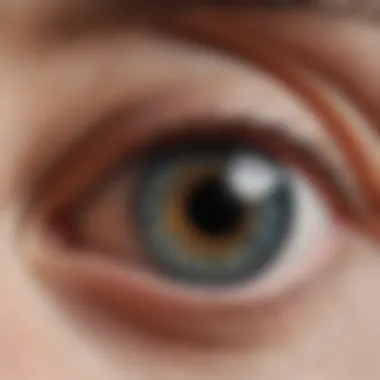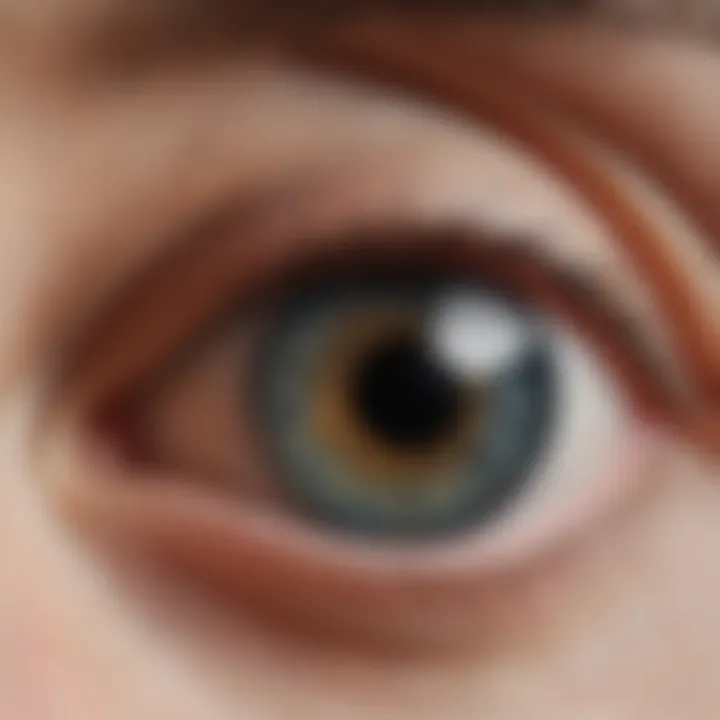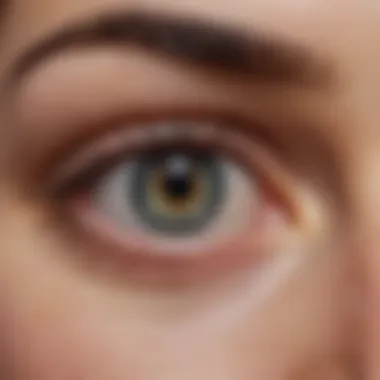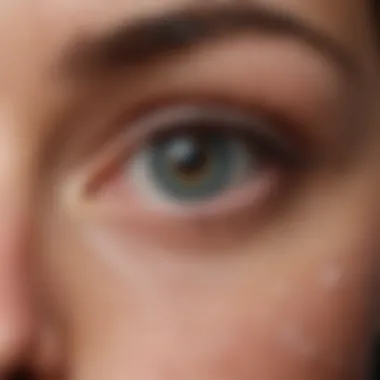Viscous Eye Drops for Dry Eyes: An In-Depth Exploration


Intro
Dry eye syndrome is a prevalent condition affecting millions. It often results from decreased tear production or increased tear evaporation. Symptoms can vary from mild discomfort to significant visual impairment. Viscous eye drops have emerged as a popular treatment option, offering an effective solution to alleviate these symptoms. This section sets the stage for a detailed exploration of the mechanisms and benefits of viscous eye drops, as well as their application in clinical practice.
Research Overview
Summary of Key Findings
Research indicates that viscous eye drops provide prolonged relief for dry eyes compared to standard eye drops. They work by enhancing tear film stability, which is crucial for maintaining ocular comfort. Key findings show that:
- Viscous formulations prolong tear film retention on the ocular surface.
- Patients report better symptom relief and satisfaction when using viscous drops.
- Improvements in visual acuity have been documented.
Background and Context
Dry eye syndrome is multifactorial and can arise due to environmental factors, age, or medical conditions. The importance of exploring viscous eye drops lies not only in their immediate benefits but also in understanding the broader implications for ocular health. The composition of these drops often includes a combination of lubricants and thickening agents, such as carboxymethylcellulose or hydroxypropyl methylcellulose. Their effectiveness relies on their ability to mimic natural tears and provide lasting relief.
Methodology
Experimental Design
To assess the efficacy of viscous eye drops, various clinical studies have been conducted. These studies typically involve a randomized controlled trial design. Participants are randomly assigned to receive either viscous eye drops or a placebo. This design allows researchers to minimize bias and accurately evaluate the treatment's effectiveness.
Data Collection Techniques
Data for these studies are collected using both subjective and objective measures. Patients report their symptom severity through standardized questionnaires. Additionally, objective analyses include tear break-up time and ocular surface staining to assess the health of the eye.
Overall, the research and methodology surrounding viscous eye drops for dry eyes reveal promising results that encourage further exploration.
Understanding Dry Eye Syndrome
Understanding dry eye syndrome is crucial as it lays the foundation for recognizing the benefits and necessity of treatments like viscous eye drops. By comprehending the underlying causes and manifestations of dry eyes, one can appreciate how viscous eye drops function and improve patient comfort. This section aims to elucidate the nature of dry eye syndrome, its prevalence, and the distinct types of these conditions. Such knowledge will facilitate informed decisions regarding appropriate therapies, ultimately enhancing quality of life for individuals affected by this condition.
Defining Dry Eyes
Dry eyes, often referred to as dry eye syndrome, is a condition characterized by insufficient lubrication on the eye's surface. The primary symptoms include discomfort, irritation, and a sensation of grittiness. It may also lead to blurred vision and an increased sensitivity to light. The deficiency can stem from inadequate tear production, poor tear quality, or environmental factors that exacerbate the condition. Defining this syndrome accurately is essential for establishing effective treatment protocols, which are particularly relevant when discussing the efficacy of viscous eye drops.
Prevalence and Significance
Dry eye syndrome is exceedingly common, affecting millions of individuals worldwide. The prevalence of this condition increases notably with age, and it can be further aggravated by lifestyle choices, medication use, and pre-existing health issues. According to estimates, around 7% to 33% of the adult population experiences symptoms. Understanding the significance of dry eyes is vital, as they can considerably diminish a person's quality of life. Chronic irritation and discomfort can lead to increased absenteeism at work, decreased productivity, and psychological impacts. Thus, recognizing dry eye syndrome is paramount for promoting early diagnosis and intervention strategies.
Types of Dry Eye Syndrome
There are two primary categories of dry eye syndrome, each with distinct causes and treatment considerations.
Evaporative Dry Eye
Evaporative dry eye is often the more common form. It results from a breakdown of the lipid layer of the tear film, leading to rapid evaporation of tears. Individuals experiencing this subtype may find their symptoms worsen in windy conditions or dry environments. A key characteristic of evaporative dry eye is the tear film instability, which can result in a variety of symptoms such as burning or itching sensations. The treatment options include the use of viscous eye drops, which can help stabilize the tear film and reduce evaporation. Advantages of addressing this type of dry eye with viscous solutions include longer-lasting relief and improved comfort, making it a beneficial focus within this article.
Aqueous Deficiency
Aqueous deficiency is characterized by insufficient tear production, attributed to conditions like Sjögren’s syndrome or aging. The hallmark of this type is the reduced volume of tears, leading to prolonged dryness and irritation. Patients may exhibit more severe symptoms compared to those with evaporative dry eyes. Addressing aqueous deficiency often requires more intensive treatments than mere lubrication. The use of viscous eye drops in this context provides significant advantages as they can enhance moisture retention and offer comfort for longer durations, thus justifying their discussion in the broader context of dry eye treatments.
Physiology of the Eye and Tear Production
Understanding the physiology of the eye and the mechanisms behind tear production is fundamental for grasping the significance of viscous eye drops in treating dry eyes. The eye relies on a delicate balance of fluids to maintain its health and function. Tears are not merely a source of moisture; they are vital for protecting the eye, providing nutrients, and facilitating clear vision. When this balance is disrupted, dry eye syndrome can arise, making adequate tear production crucial in maintaining ocular wellness.
The Role of Tear Film
The tear film consists of three main layers: the lipid layer, the aqueous layer, and the mucin layer. Each layer plays a distinct yet interdependent role in keeping the eye comfortable and lubricated. The lipid layer, which is the outermost, helps to prevent evaporation. The aqueous layer provides the bulk of the fluid, delivering moisture and nutrients to the cornea and tissues. Finally, the mucin layer ensures that the tears adhere smoothly to the eye's surface. This film acts as a barrier against pathogens and foreign particles, maintaining overall eye health.


When the tear film is compromised, eye dryness can occur. This can lead to irritation and a range of discomforting symptoms. Thus, understanding the tear film's structure and function is fundamental in evaluating how viscous eye drops can mimic or enhance natural tear production.
Components of Tears
The composition of tears is paramount in understanding their function. The main components include:
- Water: Comprising about 98% of tears, water is essential for hydration.
- Electrolytes: These maintain osmotic balance and provide nutrients.
- Proteins: Various proteins, such as lactoferrin and lysozyme, have antimicrobial properties.
- Lipids: These help stabilize the tear film and reduce evaporation.
Each of these components works synergistically to maintain ocular health. If any element is deficient, it can lead to dry eye symptoms. Viscous eye drops often contain similar substances to address this deficiency, enhancing moisture throughout the day.
Mechanism of Tear Secretion
Tears are produced primarily by the lacrimal glands located in the upper outer region of each eye. When the eye is stimulated, whether through reflex actions or environmental factors, the brain sends signals that promote tear secretion. This process is essential for maintaining an adequate tear volume on the surface of the eye.
However, in the case of dry eye syndrome, tear production may be reduced, or tears may evaporate too quickly. Viscous eye drops work by providing a longer-lasting moisture layer. They imitate the properties of natural tears, containing higher viscosity to resist evaporation and prolong the time between applications. This mechanism is integral for patients suffering from chronic dry eyes, ensuring comfort and preventing damage to the ocular surface.
"Tears are not just for emotion; they are a fundamental aspect of eye health and functionality."
This deep understanding of the eye's physiology and tear production mechanisms underscores the necessity of using appropriate treatments for dry eyes. A combination of knowledge about the tear film, its components, and the secretory mechanisms leads to a more effective selection and usage of therapy options such as viscous eye drops, ensuring the patients achieve the relief they seek.
Prologue to Viscous Eye Drops
Viscous eye drops serve as a crucial intervention for managing dry eyes, a prevalent condition impacting many individuals today. This section aims to clarify the role and significance of these specialized eye drops in treating dry eye syndrome. The unique characteristics of viscous eye drops enhance their effectiveness, leading to improved patient outcomes.
Understanding viscous eye drops begins with knowing their purpose. They are designed to provide greater moisture retention on the ocular surface. This duration of hydration is particularly essential for those suffering from varied forms of dry eye syndrome. Viscosity, the quality that allows these drops to spread evenly and adhere longer, plays a pivotal role in their success.
The need for viscous eye drops arises from the limitations of standard artificial tears. While traditional drops may offer quick relief, their effects are often short-lived. In contrast, viscous formulations create a sustained moisturizing effect. This feature is beneficial not only for chronic dry eye patients but also for those recovering from ocular surgeries or suffering from environmental irritants.
In summary, viscous eye drops are a valuable addition to the arsenal against dry eyes. More attention must be given to their composition and the specific ingredients that contribute to their effectiveness. By exploring these aspects further, we can understand how they can significantly enhance eye comfort and overall quality of life for users.
What Are Viscous Eye Drops?
Viscous eye drops are specialized formulations designed to alleviate the symptoms of dry eyes through enhanced lubrication. Their higher viscosity enables them to adhere to the ocular surface for a longer period of time compared to standard eye drops. This prolonged action helps to maintain moisture and reduce irritation, improving comfort for individuals with dry eye conditions.
Composition and Types
The effectiveness of viscous eye drops is largely derived from their unique compositions. Here, we will look at three common ingredients: Hyaluronic Acid, Polyvinyl Alcohol, and Glycerin, each contributing distinct benefits to these formulations.
Hyaluronic Acid
Hyaluronic Acid possesses remarkable hydrophilic properties, allowing it to attract and retain moisture. Its natural presence in the body aids in creating an ideal environment for eye hydration. Its key characteristic is the ability to hold several times its weight in water, making it particularly effective for eye lubrication. This property allows it to deliver sustained relief for longer periods. The unique feature of Hyaluronic Acid is its viscoelastic nature, which promotes a gel-like consistency that improves the overall comfort in dry eye management.
Advantages of Hyaluronic Acid include its compatibility with the ocular surface and its ability to reduce friction during blinking. However, there may be some drawbacks, such as potential irritation in sensitive individuals or in specific formulations that contain preservatives.
Polyvinyl Alcohol
Polyvinyl Alcohol acts as a synthetic polymer that enhances the viscosity of eye drops. Known for its lubricating properties, it creates a protective film over the eye surface. Its key characteristic is the ability to provide lasting moisture without the need for frequent applications. This quality is particularly beneficial for individuals with moderate to severe dry eyes.
A unique feature of Polyvinyl Alcohol is its stability, ensuring that it remains effective even in varying environmental conditions. However, it may sometimes lead to a sticky sensation that some users might find uncomfortable.
Glycerin
Glycerin is a well-recognized humectant that attracts water and helps to maintain hydration on the eye surface. Its importance lies in providing immediate relief and hydration to dry eyes. The primary characteristic of Glycerin is its dual role in retaining moisture while also acting as a lubricant.
As a beneficial choice in eye drops, its unique ability to create a protective layer can offer a soothing experience for users. On the downside, if concentrations are too high, Glycerin can cause a blurred vision sensation due to its thickness.
Mechanism of Action
Understanding the mechanism of action for viscous eye drops is essential for realizing their effectiveness in treating dry eye syndrome. This section will detail how the viscosity of these drops enhances eye lubrication and the duration of relief provided.
How Viscosity Affects Eye Lubrication


Viscosity plays a crucial role in how eye drops function. When discussing viscous eye drops, we refer to solutions that have a thicker consistency. This increased viscosity ensures that the drops adhere better to the ocular surface. This prolonged retention can significantly improve hydration of the corneal and conjunctival tissues.
The thickness of these drops means they can spread more evenly across the eye, reducing friction during blinking. Therefore, patients often report improved comfort compared to standard artificial tears. Viscous eye drops aim to mimic natural tear film while providing extra moisture to alleviate symptoms of dryness.
Key aspects of viscosity include:
- Adhesion: Viscous drops stick to the eye better, decreasing the frequency of application.
- Spreading: These drops can cover a wider area, ensuring that all parts of the eye receive lubrication.
- Protection: Enhanced viscosity offers a protective barrier against environmental irritants and further dehydration.
Duration of Relief
Duration of relief is another significant characteristic of viscous eye drops worth discussing. Due to their thick formulation, these drops last longer in the ocular surface than regular drops. Standard eye drops might evaporate too quickly, requiring multiple applications throughout the day. In contrast, viscous eye drops can provide extended relief, sometimes lasting up to several hours.
The duration of moisture retention can be particularly beneficial for those with chronic dry eye conditions. Patients can follow a less frequent dosing schedule, which promotes better adherence to treatment regimens. This extended comfort can significantly enhance a patient's quality of life by allowing them to engage in daily activities without constant attention to eye dryness.
In summary, the mechanisms by which viscous eye drops operate are linked directly to their viscosity and retention capabilities. These elements are essential in providing adequate moisture, comfort, and protection to patients suffering from dry eyes, making them a valuable tool in ocular therapies.
Benefits of Using Viscous Eye Drops
The utilization of viscous eye drops presents a myriad of advantages for individuals grappling with dry eyes. These benefits not only enhance ocular comfort but also contribute significantly to the overall quality of life for affected patients. This section will explore three notable advantages: enhanced moisture retention, reduced frequency of application, and improved comfort. By understanding these benefits, patients and healthcare professionals can make informed decisions regarding the incorporation of viscous eye drops into treatment regimens.
Enhanced Moisture Retention
Viscous eye drops are specially formulated to prolong the presence of moisture on the surface of the eye. Their high viscosity allows them to form a protective layer that minimizes evaporation. This is particularly important for patients who suffer from evaporative dry eye syndrome. By retaining moisture, these drops help alleviate dryness and irritation, which are common symptoms experienced by patients.
Furthermore, sustained moisture can promote healing in patients who may have superficial damage to the corneal surface. Viscosity does not just enhance comfort; it also plays a role in improving ocular health. The longer retention of moisture may facilitate the natural healing process of the eye structures, making viscous eye drops an essential option in managing chronic dryness.
Reduced Frequency of Application
Another significant benefit of viscous eye drops is the reduced frequency of application they offer. Traditional eye drops often require multiple applications throughout the day to provide relief. In contrast, because of their thicker consistency, viscous eye drops tend to stay in the eye longer, thereby decreasing the need for frequent reapplication.
Patients often find this aspect appealing, as it can lead to a more convenient treatment regimen. This reduces the burden of managing their medication schedule and alleviates the hassle of having to carry multiple bottles of drops. As a consequence of less frequent application, patients also experience more consistent relief, making it easier to engage in daily activities without the constant interruption of dryness.
Improved Comfort and Quality of Life
Last but not least, viscous eye drops significantly enhance comfort levels for those dealing with dry eyes. Many users report immediate relief from the discomfort associated with dry eyes after using these drops. Their ability to coat the eye effectively provides a soothing sensation, and this relief can extend for several hours.
This improved comfort contributes to a better quality of life for patients. Repeated discomfort from dry eyes can interfere with concentration and productivity in everyday tasks, including work and personal activities. By minimizing these symptoms through the use of viscous eye drops, individuals may find it easier to focus and engage in their routines.
"Viscous eye drops offer a multi-faceted solution for dry eye syndrome by addressing both immediate comfort and long-term health."
In summary, the benefits of using viscous eye drops are substantial. Enhanced moisture retention, reduced frequency of application, and improved comfort lead to a more manageable experience for those suffering from dry eyes. As the understanding of these advantages grows, health professionals can better advocate their use in appropriate populations.
Clinical Applications
Understanding the clinical applications of viscous eye drops is paramount for effective management of dry eyes. These drops serve a critical role in various patient demographics and clinical scenarios. Their application can greatly improve the quality of life for those suffering from dry eye syndrome, reflecting their importance in contemporary ocular health practices.
Who Should Use Viscous Eye Drops?
Patients with Chronic Dry Eyes
Patients with chronic dry eyes experience persistent issues due to several underlying factors. This condition is characterized by a deficiency in tear production or poor-quality tear film. Viscous eye drops are beneficial here, as they provide long-lasting relief. Their formulation ensures that moisture retention is maximized.
One of the main advantages for chronic dry eye patients is the extended duration these drops provide. Because they are thicker, they stay on the surface of the eye longer than standard drops. This can result in reduced discomfort and enhanced clarity of vision throughout the day. However, it is important to note that some individuals may initially find the viscosity uncomfortable. But overall, the benefits tend to outweigh these brief discomforts.
Post-Surgery Care
Post-surgery care, particularly after procedures like LASIK or cataract operations, often involves issues around lubrication and comfort. After such surgeries, patients can experience dryness due to changes in tear production. The unique characteristic of post-surgery care is the need for enhanced lubrication to support healing.
Viscous eye drops aid significantly in this area. They not only maintain moisture but also shield the corneal surface from environmental irritants, which is critical for recovery. Using these drops can lead to a smoother recovery process and minimize complications. The main disadvantage may be the initial visual blur they can cause, but this temporarily offsets the substantial benefits during the healing phase.
Integration into Treatment Protocols
Integrating viscous eye drops into treatment protocols enhances their effectiveness. Healthcare professionals can customize treatment plans based on individual patient needs, allowing for optimal outcomes. It is essential to ensure that patients understand how viscous eye drops interact with other therapies they may be receiving. Proper education about managing their use can significantly enhance patient adherence to treatment regimens. This integration not only promotes better ocular health but also reinforces the importance of comprehensive care in managing dry eye syndrome.
Potential Side Effects and Considerations


The topic of potential side effects and considerations when using viscous eye drops is crucial. Understanding these aspects ensures individuals can utilize these drops safely and effectively. While viscous eye drops offer significant benefits for dry eye syndrome, they can also have drawbacks. Recognition of common side effects, contraindications, and the importance of patient education enhances adherence to treatment and improves overall health outcomes.
Common Side Effects
Viscous eye drops are generally well-tolerated, yet, users should be aware of some common side effects. These may include:
- Blurry Vision: The increased viscosity may contribute to transient blurriness after application.
- Irritation: Some users may experience a mild burning or stinging sensation upon instillation.
- Redness: Mild redness in the eyes can occur, particularly if the drops are used frequently.
- Allergic Reactions: In rare cases, individuals may react allergically to specific components in eye drops, resulting in discomfort or swelling.
It is essential for patients to consult eye care professionals if any severe side effect develops, as this could signal an adverse reaction to the formulation.
Contraindications
Certain conditions may preclude the use of viscous eye drops. These contraindications include:
- Pre-existing Allergies: Individuals with known sensitivities to ingredients like hyaluronic acid or glycerin should avoid specific formulations.
- Eye Infections: Patients suffering from infections, such as conjunctivitis, should refrain from using these drops.
- Severe Ocular Conditions: Those with certain ocular diseases, like acute glaucoma, might find viscous eye drops unsuitable.
It is vital to check with healthcare professionals to confirm whether viscous eye drops are appropriate for each individual case.
Patient Education and Adherence
Patient education plays a significant role in ensuring successful treatment outcomes. In this regard, practitioners and pharmacists can help patients understand:
- Correct Administration Techniques: Proper techniques for instilling drops can improve efficacy and minimize side effects.
- Importance of Consistency: Regular use is critical for managing dry eye symptoms effectively, underscoring the need for adherence to prescribed regimens.
- Recognizing Side Effects: Patients should be informed on how to identify and respond to adverse effects, encouraging timely consultation with healthcare providers when needed.
Encouraging open communication between healthcare professionals and patients fosters a greater understanding of individual needs. This helps patients to feel empowered in their treatment journey.
Future Directions in Ocular Therapies
The exploration of future directions in ocular therapies is crucial for addressing the ongoing challenges faced by individuals suffering from dry eye syndrome. Unmet needs persist in the current treatment landscape, making it essential to consider innovative solutions. As research advances, understanding the implications of emerging therapies will help inform clinical practices and improve patient outcomes.
Emerging Technologies
In recent years, several technologies have emerged that show promise in treating dry eyes effectively. These advancements aim to enhance the efficacy of existing treatments while minimizing side effects. Some notable emerging technologies include:
- Nanotechnology: This involves the use of nanoparticles to deliver medications more effectively to the ocular surface. It can improve penetration and increase the duration of relief.
- Intelligent Drug Delivery Systems: These systems respond to environmental stimuli, such as pH or temperature, to release medication precisely when needed.
- Biologics and Regenerative Medicine: Utilizing biomaterials to promote healing and lubrication of ocular tissues is becoming a component of advanced therapies. This may lead to longer-lasting relief than conventional treatments.
- Wearable Technology: Some companies are developing smart contact lenses that can monitor ocular health and deliver medications as required.
These technologies are not only innovative but also transform how dry eye treatments are approached, potentially leading to personalized ocular therapies.
Research Gaps and Opportunities
Despite significant progress, there remains a considerable gap in research surrounding dry eye syndrome and its treatment. Addressing these gaps presents opportunities for advancing ocular health.
- Longitudinal Studies: There is a need for long-term studies to assess the efficacy of new therapies over time. Many studies focus on short-term outcomes, lacking a comprehensive look at patient experiences.
- Diverse Populations: Currently, much of the research is based on specific populations. Expanding the studies to include a broader demographic will help understand varied responses to treatment.
- Patient-Centric Research: Research often overlooks patient feedback. Incorporating patient perspectives into study designs can lead to more effective and acceptable therapies.
- Integration with Digital Health Solutions: The intersection of ocular health and digital health is largely unexplored. Future studies can analyze how telemedicine and mobile health tools can enhance patient management.
Filling these research gaps presents an opportunity to refine therapies and improve clinical outcomes for those suffering from dry eyes.
The End
In the exploration of viscous eye drops, several significant aspects emerge that highlight their importance in addressing dry eye syndrome. As this article illustrates, dry eye syndrome affects a large population, resulting in discomfort and impaired quality of life.
Viscous eye drops provide specific benefits, such as enhanced moisture retention and reduced frequency of application. These drops create a protective layer over the cornea, improving comfort and allowing individuals to engage in daily activities without constant interruptions due to dryness. They are beneficial for various patient groups, including those with chronic conditions and post-surgical patients.
Furthermore, there is a growing body of evidence supporting the effectiveness of these treatments, underscoring the need for continued research. Understanding their mechanisms and developing advanced formulations could lead to more targeted therapies in the future.
"Ongoing research is essential to optimize the efficacy and safety of ocular treatments, especially for those suffering from chronic dry eyes."
In summary, the role of viscous eye drops transcends mere symptom management; they represent a crucial aspect of ocular health management. As we advance, fostering awareness and enhancing research efforts will enable better treatment options for individuals suffering from dry eyes.
Summarizing Key Points
- Viscous eye drops are designed to alleviate symptoms of dry eye syndrome.
- They enhance moisture retention, providing longer-lasting relief compared to traditional eye drops.
- Their use can lead to improved quality of life for individuals with chronic dryness.
- Ongoing research opportunities exist, focusing on new formulations and technologies.
- The integration of these drops into treatment protocols highlights their clinical relevance.
The Importance of Ongoing Research
Investing in ongoing research in ocular therapies is critical. Innovation in formulations can provide better relief for patients dealing with dry eyes. Research into understanding the precise mechanisms behind the effectiveness of viscous additives like hyaluronic acid and glycerin is essential. By examining how these components interact with tear film dynamics, we can develop increased efficacy in treatment options.
Moreover, studying the long-term impact of viscous eye drops on ocular health will help in establishing comprehensive treatment protocols. Patients deserve effective solutions that not only alleviate symptoms in the short term but offer sustainable improvement in their overall ocular health. As the demand for more effective therapies grows, so will the opportunities for research that addresses unmet needs in the respiratory health domain.







